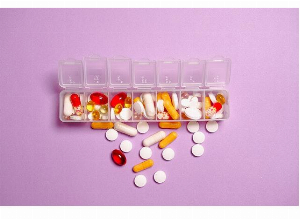Photosensitizing medications: What are they and how can their effects be prevented?
Published Jul 15, 2020 • By Alexandre Moreau
Now that summer has arrived and when taking chronic treatment, it is common to wonder if it is safe to take your treatment whilst being out in the sun. In fact, various unexpected and significant skin reactions can occur after taking a "photosensitizing" medication.

What is photosensitivity?
Photosensitivity is an adverse reaction of the skin following exposure to ultraviolet radiation (UV), whether natural (sunlight) or artificial (tanning booths) in origin. It is associated with the intake of an oral (general exposure of the body to the molecule) or local (limited to a certain area of the skin) photosensitizing drug.
There are two types of photosensitivity:
- Phototoxicity: appears rapidly (minutes to hours after sun exposure) in the form of painful burns (such as a severe sunburn). It is characterized by erythema (redness), possibly with bubbles appearing on the skin.
It is limited to areas exposed to the sun: if the application of the medication is local (cream, ointment, lotion), the reaction is only in the areas in contact with the photosensitizer. On the other hand, if the medicine is administered orally, all exposed areas are affected.
The greater the dose of medicine absorbed, the greater the reaction will be. It can occur in anyone given a high dose of photosensitizing medication. - Photoallergy: this is a delayed allergic reaction (it appears 24 to 48 hours after exposure to the sun) in the form of red patches (eczema) and itching (pruritus) that extend beyond the exposed areas and whose edges are irregular.
As with allergies, only a certain number of people are affected. It affects predisposed people, i.e. those who have already been in contact with a photosensitizing agent, and can occur at low doses of UV or photosensitizing substances. Its symptoms take longer to subside.
Which medications are photosensitizing?
Many medicines can cause photosensitivy:
- Non-steroidal anti-inflammatory drugs (NSAIDs), in gel or ointment: Ketoprofen (Oruvail®, Orudis®), Diclofenac (Voltarol®, Cambia®)
- Antibiotics: Fluoroquinolones (Ofloxacin, Ciprofloxacin, Moxifloxacin, Levofloxacin), tetracyclines (Doxycycline)
- Antiseptics: Chlorhexidine (Paroex®, Peridex®), Triclocarban (an antibacterial chemical formerly common in some soaps and lotions)
- Anti-acne agents: Isotretinoin (Accutane®), benzoyl peroxide (Epiduo®, PanOxyl®, BenzePrO®)
- Used in cardiology: antiarrhythmics such as Amiodarone (Cordarone®), calcium channel blockers such as Diltiazem (Cardizem®) or Nifedipine (Adalat®)
- Diuretics : Furosemide (Furocot®, Lasix®), Hydrochlorothiazide
- Used in neuropsychiatry: anxiolytics (Alprazolam - Xanax®), antidepressants (Paroxetine - Paxil®, Imipramine - Tofranil®), antiepileptics (Tegretol®), neuroleptics with phenothiazines (Compazine, Compro®)
- Antihistamines: against allergies and motion sickness (Promethazine - Phenergan®, Diphenhydramine- Benadryl®, Allegra®, Dramamine®)
- Antivirals: Acyclovir (Sitavig®)
- Antifungals: Ketoconazole (Extinal®, Nizoral®), Itraconazole (Onmel®, Sporanox®)
- Antiparasitics: such as antimalarial drugs (Chloroquine - Aralen®, Hydroxychloroquine - Plaquenil®)
- Hypolipidemics: with fibrates (Fenofibrate - Antara, Fenoglide) and statins (Atorvastatin - Lipitor, Simvastatin - Zocor®)
- Proton Pump Inhibitors (PPIs): Esomeprazole (Nexium®), Lansoprazole (Prevacid®)
- Anticancer drugs (used in chemotherapy)
- Contraceptives: oral and transdermal
This list is not exhaustive but brings together the main photosensitizing drugs (you can consult a more complete list compiled by the FDA here, and here for a list by the Skin Cancer Foundation). Their effects differ according to the type of medication (more pronounced with fluoroquinolones, anti-acne drugs and amiodarone), the dosage and the sensitivity of each one. This is why it is important to ask your doctor or pharmacist for advice if you are taking a treatment and plan to spend time in the sun.
It should be noted that the following message is present on the box and/or package insert of these medications in order to alert patients and prevent adverse effects of photosensitivity:
What precautions should be taken to avoid these reactions?
In the event of a photosensitive reaction, you must identify the drug or chemical substance (essential oils, cosmetics, perfumes, etc.) responsible for the effect and it must be discontinued after consulting your doctor or pharmacist. Corticosteroids may be considered as a treatment in case of photoallergy.
However, simple preventive measures remain the best solution to avoid photosensitive reactions. Indeed, whatever the nature of one's skin, one should avoid exposure to the sun at the hottest hours of the day (between 12 noon and 4 pm). You should seek shade and use protective clothing and accessories such as a long-sleeved t-shirt, hat and glasses. It is necessary to reapply anti-UVA/UVB sun cream with a high factor (factor 50) every 2 hours, especially after swimming, and apply it evenly to all exposed parts of the body. Finally, children with very sensitive skin should be particularly careful and taught how to protect themselves.
Moreover, artificial UV rays from tanning booths are just as dangerous as natural UV rays. It should therefore be avoided if you are taking a treatment involving photosensitizing medicines.
Finally, unlike UVB rays, UVA rays, although less aggressive, are more difficult to stop and pass through glass, a window or the windscreen of a car do not protect the skin and a photosensitive reaction can occur. So be careful on long car journeys, remember to protect yourself if you are taking medication that may cause a photosensitive reaction.
Was this article helpful to you? Feel free to share your thoughts with the community!
Take care!
https://ansm.sante.fr/S-informer/Points-d-information-Points-d-information/Produits-de-sante-cosmetiques-et-tatouages-en-ete-Adoptez-les-bons-reflexes-Point-d-information
https://www.ameli.fr/assure/sante/themes/coup-soleil/coup-soleil-risque-exposition-solaire
https://www.pharmacovigilance-iledefrance.fr/d%C3%A9tails-dune-br%C3%A8ve/o387
https://www.e-cancer.fr/Comprendre-prevenir-depister/Reduire-les-risques-de-cancer/Exposition-aux-rayonnements-UV
https://document.dermato-info.fr/article/pdf/photosensibilisation.pdf
https://www.fda.gov/drugs/special-features/sun-and-your-medicine
Comments
You will also like

What are the dangers associated with the over-the-counter sale of certain medicines?
Dec 19, 2020 • 6 comments


 Facebook
Facebook Twitter
Twitter

